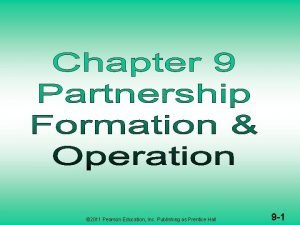Ch 6 1 Copyright 2011 Pearson Education Strategic



































- Slides: 35

Ch 6 -1 Copyright © 2011 Pearson Education

Strategic Management: Concepts and Cases Arab World Edition Fred R. David Abbas J. Ali Abdulrahman Y. Al-Aali Chapter 6: Strategies in Action Ch 6 -2 Copyright © 2011 Pearson Education

Chapter Outline • Long-Term Objectives • The Balanced Scorecard • Types of Strategies q q q Ch 6 -3 Integration Strategies Intensive Strategies Diversification Strategies Defensive Strategies Porter’s Five Generic Strategies Copyright © 2011 Pearson Education

Chapter Outline (cont’d) • Means For Achieving Strategies • Strategic Management in Nonprofit and Governmental Organizations • Strategic Management in Small Firms Ch 6 -4 Copyright © 2011 Pearson Education

Long Term Objectives • Represent the results expected from pursuing certain strategies • Then strategies represent the actions to be taken to accomplish long – term objectives • The time frame for objectives and strategies should be consistent (usually from two to five years ) Ch 5 -5

The Nature of long-term objectives: • Quantifiable • Hierarchical • Measurable • Obtainable • Realistic • Timeline • Understandable • Challenging • Congruent among organizational units Ch 5 -6 Ch 6 -6 Copyright © 2011 Pearson Education

Objectives are communally stated in terms such as the following • • • Ch 5 -7 Growth in sales Profitability Market share Degree and nature of diversification Degree and nature of vertical integration Social responsibility

Why stated and communicated objectives are vital to success? 1. 2. 3. 4. • Ch 5 -8 Objectives help stakeholders understand their role in an organization’s future Provide a basis for consistent decision making by managers whose values and attitudes differs By reaching a consensus on objectives during strategy – formulation activates- the organization can minimize potential conflicts later during implementation Objectives serve as standards by which individuals , groups, departments, divisions and entire organizations can be evaluated objectives also provide directions and allow for organizations synergy

Financial vs. Strategic Objectives Financial Objectives • Growth in revenues • Growth in earnings • Higher dividends • Higher profit margins • Greater return on investment • Higher earnings per share • Rising stock price • Improved cash flow Ch 5 -9 Ch 6 -9 Copyright © 2011 Pearson Education

Strategic objectives • • • Ch 5 -10 Development in brands Larger market share Quicker on time delivery than rivals Shorter design- to market time than rivals Lower costs than rivals Higher product quality Wider geographic coverage Achieving ISO 14001 Technological leadership

Is there any conflict between the financial objectives and strategic objectives. Some times it could be some conflict between them organizations sometimes to achieve the financial objectives can harm the long run strategic objectives • (Higher dividends –technology leadership ) • trade- off between them is important • Priorities decisions have to be made. • Ch 5 -11

Not Managing by Objectives Strategists should avoid the ways to not managing by objectives • Managing by Extrapolation – If it isn't broke, don’t fix it. • Managing by Crisis – The true measure of a good strategist is the ability to fix problems. • Managing by Subjective – Do your own thing, the best way you know how. • Managing by Hope – The future is full of uncertainty and if first you don’t succeed, then you may on the second or third try. Ch 5 -12 Ch 6 -12 Copyright © 2011 Pearson Education

The Balanced Scorecard Robert Kaplan & David Norton • It is a strategy evaluation & control technique • Balance financial measures with nonfinancial measures • Balance shareholder objectives with customer & operational objectives • Several Arab agencies have adopted the balance scorecard approach in recent years (Abu Dhabi – saudia Arabia- dubai ) Ch 6 -13 Copyright © 2011 Pearson Education

The Balanced Scorecard • The core concept of the balanced scorecard • A balanced scorecard for a firm is a simply listing of all key objectives (financial and non financial ) such customer service – employees morals – product quality – pollution abatement , business ethics , social responsibility ……etc. Ch 5 -14

Source: Adapted from Fred R. David, “How Companies Define Their Mission, ” Long Range Planning 22, no. 3 (June 1988) 40. Ch 6 -15 Copyright © 2011 Pearson Education

Types of Strategies • Three important strategies have been displayed Growth strategy (offensive ) • Involve increasing investment , this implies that the company is aggressively trying to change its industry and competiton condition • Retrenchment strategy (Defensive ) • Is a defensive strategy where the company seek to protect its position and hopefully minimize exposure to risk. this means that the company applies a course of action that limits the size or the kind of its market involvement • Ch 5 -16

The stability strategy (maintain the status quo ) it means that company avoid undertaking any changes and keep satisfy with the current market position. • In today’s global market this strategy is not fit. It is mostly found in small enterprises • For this reason we will focus in detail on the other types of strategies only • Ch 5 -17

Definitions of the alternative types of strategies q Vertical integration (forward ) gaining ownership or increased control over distributions or retailers q Vertical integration (backward) seeking ownership or increased control of a firm’s ownership q Horizontal integration seeking ownership or increased control over competitors Ch 5 -18

q q q Ch 5 -19 Market penetration seeking increased market share for existing products or services in existing markets through greater market effort Market developmenet introducing existing product into new geographic area Product development seeking increased sales by improving & modifying the existing product Innovation introducing completely new product or service Related diversification adding new but related products or services

q Unrelated diversification unrelated products or services q Retrenchment regrouping through cost and asset reduction to reverse declining sales and profit q Divestiture organization q Liquidation selling all of a company ‘s assets , in parts , for their tangible worth Ch 5 -20 adding new selling a division or part of an

Notes • Most organizations simultaneously pursue a combination of these strategies. • Organizations have limited resources and incomplete information , thus priorities must be undertaken (choose among alternative) • Ch 5 -21

Levels of Strategies and the person who is responsible Corp Level A Large & small Company Chief executive officer Division Level Division president& vice president Functional Level Function manger Operational Level Plant manger – sales manger – production manager Ch 5 -22 Ch 6 -22 Copyright © 2011 Pearson Education

Owner /president Functional manger Operation level Ch 5 -23

Types of Strategies Forward Integration Strategies Backward Integration Horizontal Integration Ch 5 -24 Ch 6 -24 Copyright © 2011 Pearson Education

Types of Strategies Market Penetration Intensive Strategies Market Development Product Development Innovation Ch 5 -25 Ch 6 -25 Copyright © 2011 Pearson Education

Types of Strategies Related Diversification Strategies Unrelated Diversification Ch 5 -26 Ch 6 -26 Copyright © 2011 Pearson Education

Types of Strategies Retrenchment Defensive Strategies Divestiture Liquidation Ch 5 -27 Ch 6 -27 Copyright © 2011 Pearson Education

Michael Porter’s Generic Strategies Cost Leadership Strategies (Low-Cost & Best-Value) Producing standardized products at a very low per unit cost for consumers who are price- sensitive Differentiation Strategies Means producing products & services considered unique across the industry Focus Strategies means producing products & service That fulfill the needs of small groups of consumers Ch 6 -28 Copyright © 2011 Pearson Education

Means for Achieving Strategies • Joint Venture/Partnering • Mergers and Acquisitions • Private Equity Acquisitions • First-Mover Advantages • Outsourcing Ch 6 -29 Copyright © 2011 Pearson Education

Joint Venture/Partnering • Joint venture is a popular strategy • Two or more companies form a temporary partnership for the purpose of capitalizing on some opportunity. • Unlike the many U. S. counterparts, Arab corporations have sought cooperative and joint venture agreements with global corporations Ch 6 -30 Copyright © 2011 Pearson Education

Mergers and Acquisitions • A merger occurs when two organizations of about equal size unite to form one enterprise • An acquisition occurs when a large organization purchases a smaller firm or vice versa Ch 6 -31 Copyright © 2011 Pearson Education

Mergers and Acquisitions (cont’d) Key reasons why mergers and acquisitions fail: (important ) • Inadequate evaluation of target • Large debt • Inability to achieve synergy (Synergy means 1+1= more than 2) • Too much diversification • Difficult to integrate different organizational cultures • Reduced employee morale due to layoffs and relocations Ch 6 -32 Copyright © 2011 Pearson Education

Outsourcing Business-Process Outsourcing (BPO) Companies taking over the functional operations of other firms. Ch 6 -33 Copyright © 2011 Pearson Education

Strategic Management in Nonprofit and Governmental Organizations • In Arab world the non- profit and governmental organizations are successfully applying strategic management • Educational institutions are more frequently using strategic management techniques and concepts (as ex. universities across the region have adopted strategic planning to manage their resources and develop realistic plans for the future ) • Medical Organizations: - many strategies being pursued by many hospitals as such creating home health services , acquiring ambulance service and diagnostic service Ch 6 -34 Copyright © 2011 Pearson Education

Strategic Management in Small Firms • 95% of all businesses in the Arab world region are family firms • Most Arab entrepreneurs start off as owners of small and medium-sized firms • Strategic management is vital for small companies • Lack of strategic management knowledge is a serious obstacle for many small business owners Ch 6 -35 Copyright © 2011 Pearson Education
 Pearson education 2011
Pearson education 2011 2011 pearson education inc
2011 pearson education inc 2011 pearson education inc
2011 pearson education inc 2011 pearson education inc
2011 pearson education inc 2011 pearson education inc
2011 pearson education inc 2011 pearson education inc
2011 pearson education inc 2011 pearson education inc
2011 pearson education inc 2011 pearson education inc
2011 pearson education inc 2011 pearson education inc
2011 pearson education inc 2011 pearson education inc
2011 pearson education inc 2011 pearson education inc
2011 pearson education inc 2011 pearson education inc
2011 pearson education inc Pearson education inc. publishing as prentice hall
Pearson education inc. publishing as prentice hall 2011 pearson education
2011 pearson education 2011 pearson education inc biology
2011 pearson education inc biology 2011 pearson education inc
2011 pearson education inc 2011 pearson education inc biology
2011 pearson education inc biology Pearson education inc publishing
Pearson education inc publishing 2011 pearson education inc
2011 pearson education inc Pearson education inc. publishing as prentice hall
Pearson education inc. publishing as prentice hall Pearson education ltd
Pearson education ltd Copyright by pearson education inc. answers
Copyright by pearson education inc. answers Copyright 2010 pearson education inc
Copyright 2010 pearson education inc Copyright 2009
Copyright 2009 Copyright pearson education inc
Copyright pearson education inc 2014 pearson education inc
2014 pearson education inc Copyright 2010 pearson education inc
Copyright 2010 pearson education inc Copyright 2010 pearson education inc
Copyright 2010 pearson education inc Copyright by pearson education inc. answers
Copyright by pearson education inc. answers 2008 pearson education inc
2008 pearson education inc Copyright 2009 pearson education inc
Copyright 2009 pearson education inc 2015 pearson education inc
2015 pearson education inc Copyright 2010 pearson education inc
Copyright 2010 pearson education inc Copyright 2010 pearson education inc
Copyright 2010 pearson education inc Copyright 2010 pearson education inc
Copyright 2010 pearson education inc Copyright 2010 pearson education inc
Copyright 2010 pearson education inc


























































